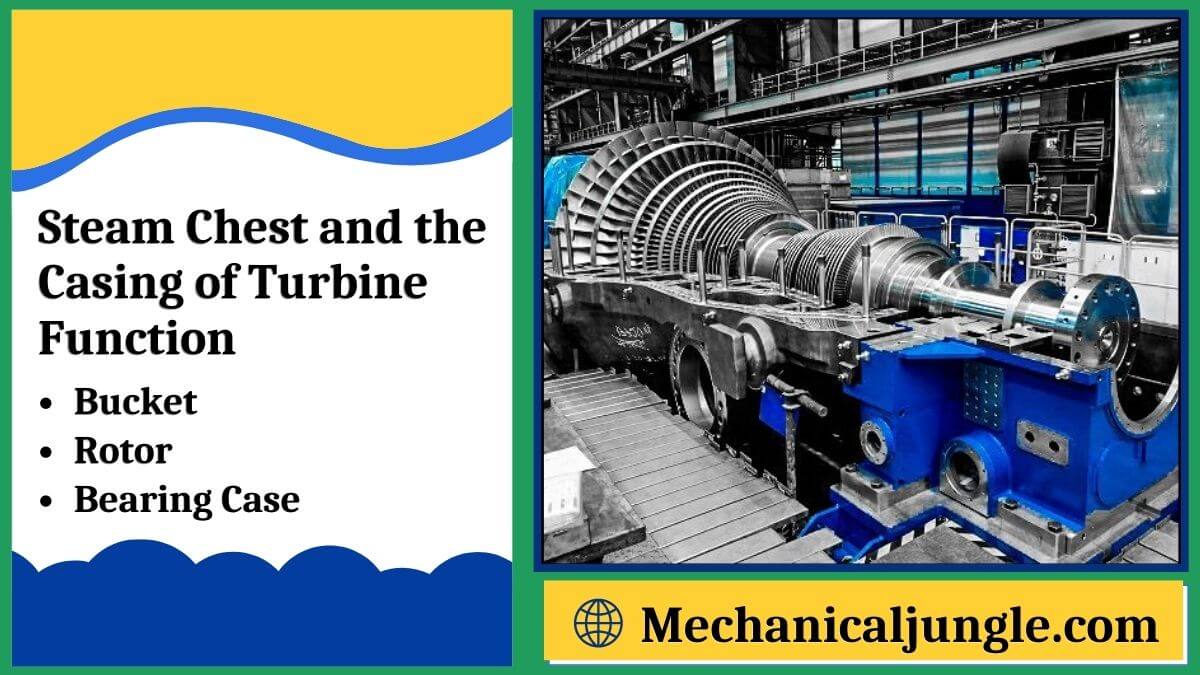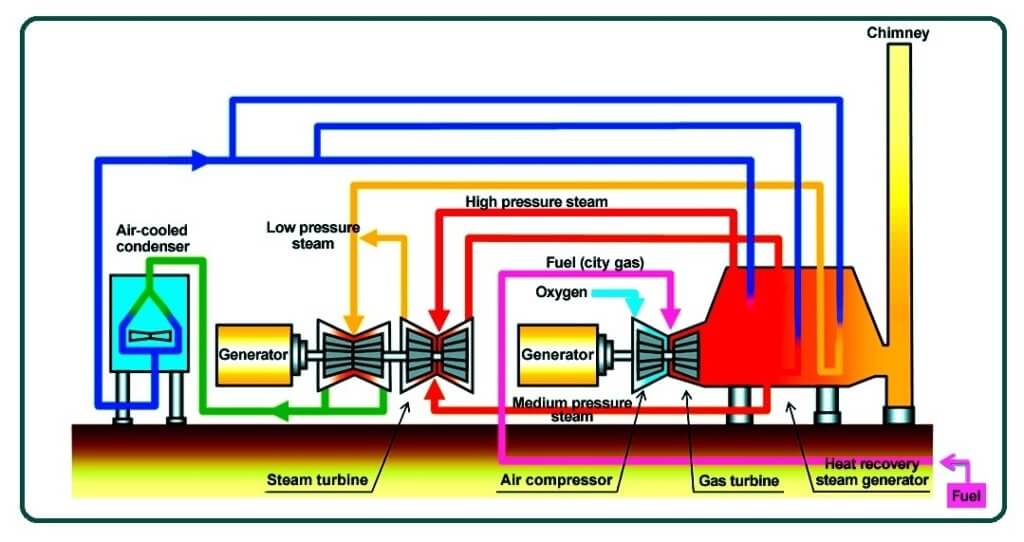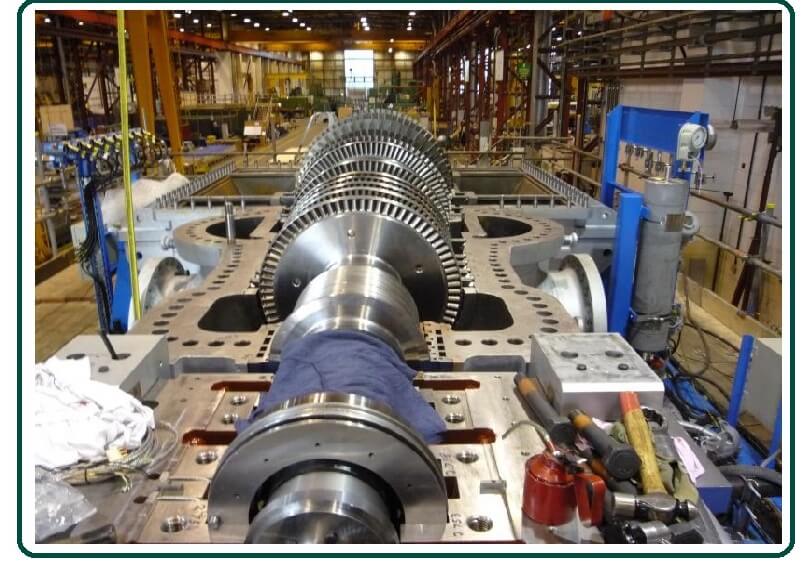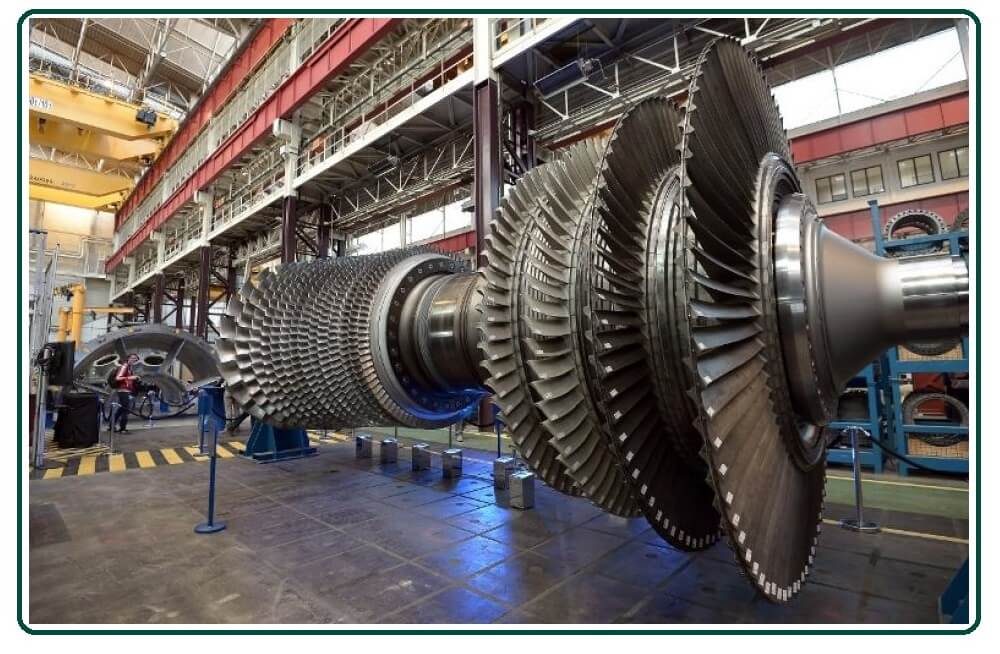
Turbine Function:

Turbines vary greatly depending on their application; They can be used to harness wind power in wind turbines, the water of a river or barrier lake in a hydropower plant, hot gas in a thermal power plant, or steam created in a nuclear reactor 1. Turbines exploit a system of blades to spin and, through a shaft, drive the generator.
The generator is composed of a moving part, rotor, and a stationary part, the stators. The outers layer of the rotor is coated in electromagnets, and the inner wall of the stators is lined with coils of copper wires.
When the rotor turns, it creates a rotating magnetic field, which induces alternating currents in the stator. The power generated is channeled through a transformer, which raises the voltage to an appropriate level for use in power transmission systems.
Turbine Function of Thermal Power Plant:

The thermal power plant is equipped with boilers – some up to 90 meters long – heated by a burner ignited in a powder with coal, fuel oil vaporized into fine droplets or natural gas.
The heat produced is used to raise the temperature of a circuit of water until it turns into steam, which is then run through a series of turbines under high pressure.
The turbines provide power to the generator while the steam is evacuated and condensed back into the water and converted into liquid form.
Pressurized water reactors operate on the same principle. The cycle is performed in two distinctly distinct circuits: the primary circuit is connected to a nuclear reactor and the secondary circuit to turbines.
The primary circuit transfers the heat generated by the nuclear reaction to the secondary circuit via a steam generator.
The steam passes through the high-pressure turbine, where it partially expands and is then directed through several low-pressure turbines. Turbines together can measure distances up to 60 meters. The generator turns at a speed of 1,500 revolutions per minute.
What Is Steam Turbine Function?

A steam turbine is a type of heat engine machine in which the heat energy of steam is converted into mechanical work. The construction of steam turbines is very simple.
This is not a piston rod; flywheel or slide valves are attached to the turbine. It is a rotor and a set of rotating blades that attach to the shaft, and the shaft is placed in the middle of the rotor.
An electric generator, known as a steam turbine generator, is connected to the rotor shaft. This turbine generator collects mechanical energy from the shaft and converts it into electrical energy. The beam turbine generator also improves turbine efficiency.
History of Steam Turbine Function:
The first steam turbine was invented by the Greek mathematician Hero of Alexandria around 120 BC. I did it, and it was kind of mutual. The modern steam turbine was built in the year 1884 by Sir Charl Parsons. This design has been changed several times.
Turbine capacity is coming from 0.75 kW to 1000 MW. It has a wides range of uses, such as pumps, compressors, etc. Modern steam turbines are also used as prime movers in a large thermal power plant.
Working Principle of Steam Turbine Function:

The working principle of a steam turbine depends on the dynamic action of vapor. The high-velocity steam is coming from the nozzles, and it collides with rotating blades that are fitted to the discs on the shaft.
High-velocity steam produces dynamic pressure on the steam blade in which both the blade and the shaft rotate in the same direction. Typically, a vapor turbine of steam extracts is converted into pressure energy and then to kinetic energy that allows steam to flow through the nozzles.
The conversion of kinetic energy is mechanical and works for the rotor blades, and the rotors are connected to a steam turbine generator, which acts as an intermediary. The turbine generator collects mechanical energy from the rotor and converts it into electrical energy.
Then the construction of a steam turbine is simple; its vibration is much lower than other engines for the same rotational speed. However, different types of governance systems are used to improve turbine speed.
Steam Chest and the Casing of Turbine Function:
They are respectively connected to a high-pressure steam supply line and a low-pressure steam exhaust line. The casing has a steam chest, governor valve, and over-speed trip valve. The casing consists of a rotor and nozzles through which steam expands and is directed against the rotating.
#1. Bucket.
Three examples of uses for the Steam chest and the casing are given below.
#2. Rotor.
Includes shafts and disk assembly with buckets. The shafts extend beyond the casing through the bearing cases. One end of the shafts is used for coupling the driven pump. The other end of the shaft serves as the speed governor and over-speed trip system.
#3. Bearing Case.
The rotor supports and assembles the casing and steam chest. Bearing cases include journal bearings and rotating oil seals, which externally prevent.
Frequently Asked Questions (FAQ) about Steam Turbines in Power Generation:
What is a steam turbine and how does it work?
A steam turbine is a heat engine that converts the energy of steam into mechanical work. It operates on the principle of high-velocity steam impacting rotating blades attached to a shaft, which in turn drives a generator to produce electricity.
What are the main components of a steam turbine?
A steam turbine typically consists of a rotor with blades, a shaft, a steam chest for steam supply, a casing, and a generator. The rotor and blades convert steam energy into rotational motion, which is then used to generate electricity.
What are the applications of steam turbines?
Steam turbines are widely used in thermal power plants for electricity generation. They also power various industrial processes such as pumps and compressors, and are integral to nuclear power plants where they convert heat from nuclear reactions into electricity.
How efficient are steam turbines in power generation?
Modern steam turbines can achieve high efficiency, typically ranging from 30% to 40% for fossil fuel power plants and higher for combined cycle plants. Efficiency improvements are ongoing with advancements in turbine design and materials.
What is the history of steam turbines?
The concept of steam turbines dates back to ancient times, but the modern steam turbine was developed by Sir Charles Parsons in 1884. Since then, steam turbine technology has evolved significantly, leading to its widespread adoption in power generation.
What are the advantages of using steam turbines?
Steam turbines are known for their reliability, scalability, and ability to generate large amounts of electricity continuously. They can utilize a variety of fuels, including coal, natural gas, and nuclear energy, making them versatile in different power generation settings.
How are steam turbines maintained and operated?
Maintenance of steam turbines involves regular inspection of blades, bearings, and steam seals. Operators monitor steam pressure, temperature, and turbine speed to ensure optimal performance and safety. Over-speed protection systems are also crucial for turbine operation.
What are the environmental considerations of steam turbines?
Steam turbines in thermal power plants contribute to greenhouse gas emissions depending on the fuel used. Efforts are ongoing to improve efficiency and reduce emissions through technologies like carbon capture and storage (CCS) and renewable energy integration.
What role do steam chests and casings play in steam turbines?
Steam chests supply high-pressure steam to the turbine blades, while casings enclose the turbine components and direct steam flow. They house governing systems to control turbine speed and ensure safe operation, including over-speed trip valves for emergency shutdowns.
What is the future outlook for steam turbine technology?
The future of steam turbines includes advancements in materials, digital monitoring systems, and integration with renewable energy sources like solar thermal and biomass. Research focuses on enhancing efficiency, reducing maintenance costs, and minimizing environmental impacts.

